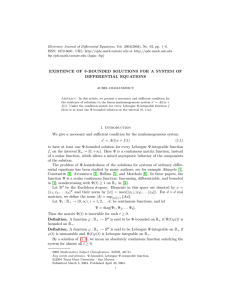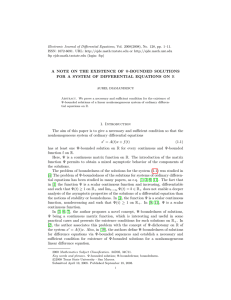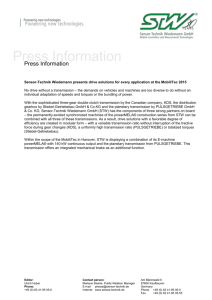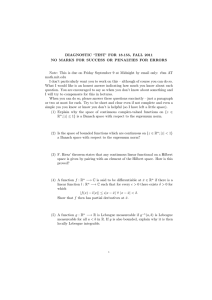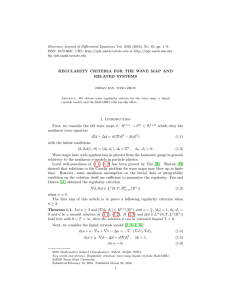Electronic Journal of Differential Equations, Vol. 2009(2009), No. 05, pp.... ISSN: 1072-6691. URL: or
advertisement
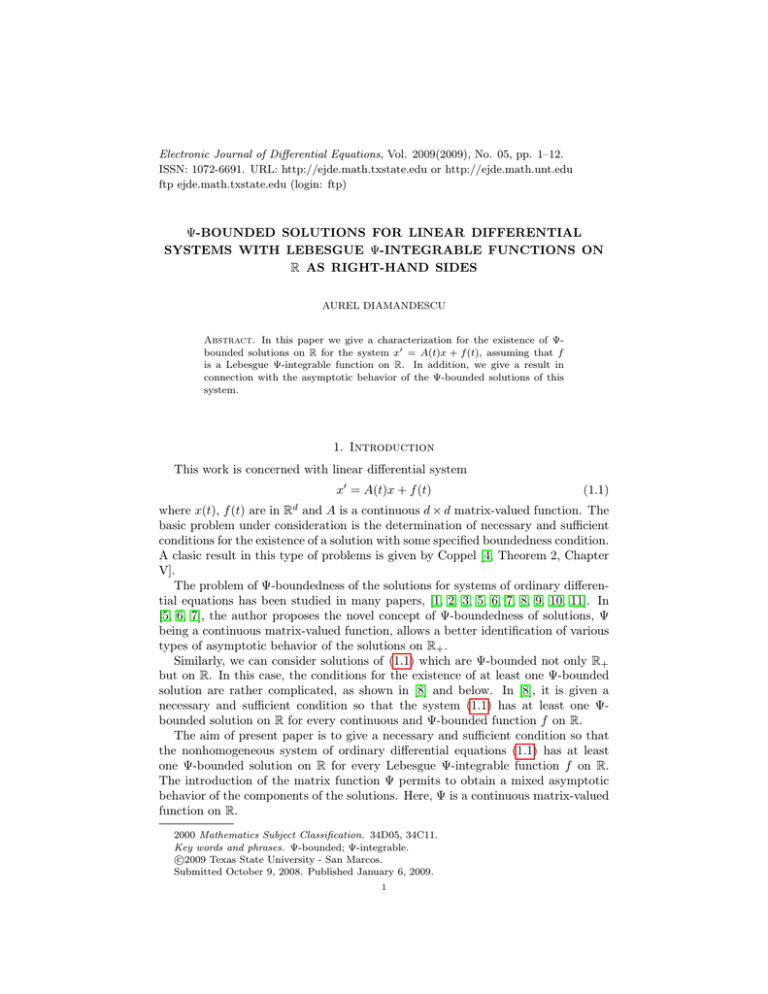
Electronic Journal of Differential Equations, Vol. 2009(2009), No. 05, pp. 1–12.
ISSN: 1072-6691. URL: http://ejde.math.txstate.edu or http://ejde.math.unt.edu
ftp ejde.math.txstate.edu (login: ftp)
Ψ-BOUNDED SOLUTIONS FOR LINEAR DIFFERENTIAL
SYSTEMS WITH LEBESGUE Ψ-INTEGRABLE FUNCTIONS ON
R AS RIGHT-HAND SIDES
AUREL DIAMANDESCU
Abstract. In this paper we give a characterization for the existence of Ψbounded solutions on R for the system x0 = A(t)x + f (t), assuming that f
is a Lebesgue Ψ-integrable function on R. In addition, we give a result in
connection with the asymptotic behavior of the Ψ-bounded solutions of this
system.
1. Introduction
This work is concerned with linear differential system
x0 = A(t)x + f (t)
d
(1.1)
where x(t), f (t) are in R and A is a continuous d × d matrix-valued function. The
basic problem under consideration is the determination of necessary and sufficient
conditions for the existence of a solution with some specified boundedness condition.
A clasic result in this type of problems is given by Coppel [4, Theorem 2, Chapter
V].
The problem of Ψ-boundedness of the solutions for systems of ordinary differential equations has been studied in many papers, [1, 2, 3, 5, 6, 7, 8, 9, 10, 11]. In
[5, 6, 7], the author proposes the novel concept of Ψ-boundedness of solutions, Ψ
being a continuous matrix-valued function, allows a better identification of various
types of asymptotic behavior of the solutions on R+ .
Similarly, we can consider solutions of (1.1) which are Ψ-bounded not only R+
but on R. In this case, the conditions for the existence of at least one Ψ-bounded
solution are rather complicated, as shown in [8] and below. In [8], it is given a
necessary and sufficient condition so that the system (1.1) has at least one Ψbounded solution on R for every continuous and Ψ-bounded function f on R.
The aim of present paper is to give a necessary and sufficient condition so that
the nonhomogeneous system of ordinary differential equations (1.1) has at least
one Ψ-bounded solution on R for every Lebesgue Ψ-integrable function f on R.
The introduction of the matrix function Ψ permits to obtain a mixed asymptotic
behavior of the components of the solutions. Here, Ψ is a continuous matrix-valued
function on R.
2000 Mathematics Subject Classification. 34D05, 34C11.
Key words and phrases. Ψ-bounded; Ψ-integrable.
c
2009
Texas State University - San Marcos.
Submitted October 9, 2008. Published January 6, 2009.
1
2
A. DIAMANDESCU
EJDE-2009/05
2. Definitions, Notations and hypotheses
Let Rd be the Euclidean d-space. For x = (x1 , x2 , x3 , . . . , xd )T ∈ Rd , let kxk =
max{|x1 |, |x2 |, |x3 |, . . . , |xd |} be the norm of x. For a d × d real matrix A = (aij ),
we define the norm |A| = supkxk≤1 kAxk. It is well-known that
d
X
|A| = max {
|aij |}.
1≤i≤d
j=1
Let Ψi : R → (0, ∞), i = 1, 2, . . . d, be continuous functions and
Ψ = diag[Ψ1 , Ψ2 , . . . Ψd ].
Definition. A function ϕ : R → Rd is said to be Ψ-bounded on R if Ψϕ is
bounded on R.
Definition. A function ϕ : R → Rd is said to be Lebesgue Ψ-integrable on R if
ϕ is measurable and Ψϕ is Lebesgue integrable on R.
By a solution of (1.1), we mean an absolutely continuous function satisfying
(1.1) for almost all t ∈ R.
Let A be a continuous d × d real matrix and let the associated linear differential
system be
y 0 = A(t)y.
(2.1)
Let Y be the fundamental matrix of (2.1) for which Y (0) = Id (identity d × d
matrix).
Let the vector space Rd be represented as a direct sum of three subspaces X− ,
X0 , X+ such that a solution y(t) of (2.1) is Ψ-bounded on R if and only if y(0) ∈ X0
and Ψ-bounded on R+ = [0, ∞) if and only if y(0) ∈ X− ⊕ X0 . Also, let P− , P0 , P+
denote the corresponding projection of Rd onto X− , X0 , X+ respectively.
3. Main result
Theorem 3.1. If A is a continuous d × d real matrix on R, then (1.1) has at least
one Ψ-bounded solution on R for every Lebesgue Ψ-integrable function f : R → Rd
on R if and only if there exists a positive constant K such that
|Ψ(t)Y (t)P− Y −1 (s)Ψ−1 (s)| ≤ K
|Ψ(t)Y (t)(P0 + P− )Y
|Ψ(t)Y (t)P+ Y
−1
−1
−1
(s)Ψ
−1
(s)Ψ
|Ψ(t)Y (t)P− Y
−1
(s)| ≤ K
(s)| ≤ K
−1
(s)Ψ
|Ψ(t)Y (t)P+ Y
−1
(s)Ψ
(s)| ≤ K
(s)| ≤ K
for t > 0, s > 0, s < t
for t > 0, s > 0, s ≥ t
|Ψ(t)Y (t)(P0 + P+ )Y −1 (s)Ψ−1 (s)| ≤ K
−1
for t > 0, s ≤ 0
for t ≤ 0, s < t
(3.1)
for t ≤ 0, s ≥ t, s < 0
for t ≤ 0, s ≥ t, s ≥ 0
Proof. First, we prove the “only if” part. Thus, suppose that the system (1.1) has
at least one Ψ-bounded solution on R for every Lebesgue Ψ-integrable function f :
R → Rd on R.
We shall denote by CΨ the Banach space of all Ψ-bounded and continuous functions x : R → Rd with the norm kxkCΨ = supt∈R kΨ(t)x(t)k and by B the Bad
nach space
R +∞of all Lebesgue Ψ-integrable functions x : R → R with the norm
kxkB = −∞ kΨ(t)x(t)kdt.
EJDE-2009/05
Ψ-BOUNDED SOLUTIONS
3
We shall denote by D the set of all functions x : R → Rd which are absolutely
continuous on all intervals J ⊂ R, Ψ-bounded on R, x(0) ∈ X ⊕ X+ and x0 − Ax ∈
B.
Obviously, D is a vector space and x → kxkD = kxkCΨ + kx0 − AxkB is a norm
on D.
Step 1. (D, k · kD ) is a Banach space. Let (xn )n∈N be a fundamental sequence
of elements of D. Then, it is a fundamental sequence in CΨ . Therefore, there exists
a continuous and Ψ-bounded function x : R → Rd such that limn→∞ Ψ(t)xn (t) =
Ψ(t)x(t), uniformly on R. From the inequality
kxn (t) − x(t)k ≤ |Ψ−1 (t)|kΨ(t)xn (t) − Ψ(t)x(t)k,
t ∈ R,
it follows that limn→∞ xn (t) = x(t), uniformly on every compact of R. Thus,
x(0) ∈ X− ⊕ X+ .
On the other hand, the sequence (fn )n∈N , where fn (t) = x0n (t) − A(t)xn (t), is a
fundamental sequence in the Banach space B. Thus, there exists f ∈ B such that
Z +∞
lim
kΨ(t)(fn (t) − f (t))kdt = 0.
n→∞
−∞
For a fixed, but arbitrary, t ∈ R, we have
x(t) − x(0) = lim xn (t) − xn (0)
n→∞
Z t
= lim
x0n (s)ds
n→∞ 0
Z t
[Ψ−1 (s)(Ψ(s)(fn (s) − f (s)) + f (s) + A(s)xn (s)]ds
= lim
n→∞ 0
Z t
=
f (s) + A(s)x(s) ds.
0
0
It follows that x − Ax = f ∈ B and x is absolutely continuous on all intervals
J ⊂ R. Thus, x ∈ D.
Now, from
lim Ψ(t)xn (t) = Ψ(t)x(t), uniformly on R
n→∞
and
Z
+∞
lim
n→∞
kΨ(t)[(x0n (t) − A(t)xn (t)) − (x0 (t) − A(t)x(t))]kdt = 0,
−∞
it follows that limn→∞ kxn − xkD = 0. Thus, (D, k · kD ) is a Banach space.
Step 2. There exists a positive constant K such that, for every f ∈ B and for
corresponding solution x ∈ D of (1.1), we have
Z +∞
sup kΨ(t)x(t)k ≤ K
kΨ(t)f (t)kdt,
(3.2)
t∈R
−∞
For this, define the mapping T : D → B, T x = x0 − Ax. This mapping is obviously
linear and bounded, with kT k ≤ 1.
Let T x = 0. Then, x0 = Ax, x ∈ D. This shows
that x is a Ψ-bounded solution
on R of (2.1). Then, x(0) ∈ X0 ∩ X− ⊕ X+ = {0}. Thus, x = 0, such that the
mapping T is “one-to-one” .
4
A. DIAMANDESCU
EJDE-2009/05
Now, let f ∈ B and let x be the Ψ-bounded solution on R of the system (1.1)
which exists by assumption. Let z be the solution of the Cauchy problem
x0 = A(t)x + f (t),
z(0) = (P− + P+ )x(0).
Then u = x − z is a solution of (2.1) with u(0) = x(0) − (P− + P+ )x(0) = P0 x(0).
From the Definition of X0 , it follows that u is Ψ-bounded on R. Thus, z is Ψbounded on R. Therefore, z belongs to D and T z = f . Consequently, the mapping
T is “onto” .
From a fundamental result of Banach: “If T is a bounded one-to-one linear
operator of one Banach space onto another, then the inverse operator T −1 is also
bounded” , we have kT −1 f kD ≤ kT −1kkf kB , for all f ∈ B.
For a given f ∈ B, let x = T −1 f be the corresponding solution x ∈ D of (1.1).
We have
kxkD = kxkCΨ + kx0 − AxkB = kxkCΨ + kf kB ≤ kT −1kkf kB
or
kxkCΨ ≤ kT −1 k − 1 kf kB = Kkf kB .
This inequality is equivalent to (3.2).
Step 3. The end of the proof. Let T1 < 0 < T2 be a fixed points but arbitrarily,
and let f : R → Rd a function in B which vanishes on (−∞, T1 ] ∪ [T2 , +∞). It is
easy to see that the function x : R → Rd defined by
R
RT
0
Y (t)P0 Y −1 (s)f (s)ds − T12 Y (t)P+ Y −1 (s)f (s)ds, t < T1
T1
−
R
R
t Y (t)P Y −1 (s)f (s)ds + t Y (t)P Y −1 (s)f (s)ds
−
0
TR
0
1
x(t) =
T2
−1
−
Y
(t)P
Y
(s)f
(s)ds,
T 1 ≤ t ≤ T2
+
t
R T2 Y (t)P Y −1 (s)f (s)ds + R T2 Y (t)P Y −1 (s)f (s)ds,
t > T2
−
0
0
T1
is the solution in D of the system (1.1). Now, we put
Y (t)P− Y −1 (s),
Y (t)(P0 + P− )Y −1 (s),
−Y (t)P Y −1 (s),
+
G(t, s) =
−1
Y
(t)P
Y
(s),
−
−Y (t)(P0 + P+ )Y −1 (s),
−Y (t)P+ Y −1 (s),
s ≤ 0 < t,
0 < s < t,
0 < t ≤ s,
s < t ≤ 0,
t ≤ s < 0,
t ≤ 0 ≤ s.
This function is continuous on R2 except on the line t = s, where it has a jump
RT
discontinuity. Then, we have that x(t) = T12 G(t, s)f (s)ds, t ∈ R. Indeed,
• for t < T1 , we have
Z T2
G(t, s)f (s)ds
T1
Z
0
=−
Y (t)(P0 + P+ )Y −1 (s)f (s)ds −
T1
Z 0
=−
= x(t)
T2
Y (t)P+ Y −1 (s)f (s)ds
0
Y (t)P0 Y
T1
Z
−1
Z
T2
(s)f (s)ds −
T1
Y (t)P+ Y −1 (s)f (s)ds
EJDE-2009/05
Ψ-BOUNDED SOLUTIONS
• for t ∈ [T1 , 0], we have
Z T2
Z t
Z
G(t, s)f (s)ds =
Y (t)P− Y −1 (s)f (s)ds −
T1
T1
0
Y (t)(P0 + P+ )Y −1 (s)f (s)ds
t
T2
Z
−
Z
5
Y (t)P+ Y −1 (s)f (s)ds
Z t
−1
Y (t)P0 Y −1 (s)f (s)ds
Y (t)P− Y (s)f (s)ds +
0
t
=
0
T1
T2
Z
−
Y (t)P+ Y −1 (s)f (s)ds
t
= x(t),
• for t ∈ (0, T2 ], we have
Z T2
Z 0
Z t
G(t, s)f (s)ds =
Y (t)P− Y −1 (s)f (s)ds +
Y (t)(P0 + P− )Y −1 (s)f (s)ds
T1
T1
0
Z
−
Z
T2
Y (t)P+ Y −1 (s)f (s)ds
Z t
−1
Y (t)P− Y (s)f (s)ds +
Y (t)P0 Y −1 (s)f (s)ds
t
t
=
T1
0
Z
T2
−
Y (t)P+ Y −1 (s)f (s)ds
t
= x(t),
• for t > T2 , we have
Z T2
Z
G(t, s)f (s)ds =
T1
0
Y (t)P− Y −1 (s)f (s)ds +
T1
Z T2
=
T2
Z
Y (t)(P0 + P− )Y −1 (s)f (s)ds
0
Y (t)P− Y
−1
T2
Z
(s)f (s)ds +
T1
Y (t)P0 Y −1 (s)f (s)ds
0
= x(t).
Now, the inequality (3.2) becomes
Z T2
Z
sup kΨ(t)
G(t, s)f (s)dsk ≤ K
t∈R
T1
T2
kΨ(t)f(t)kdt.
T1
For a fixed points s ∈ R, δ > 0 and ξ ∈ Rd , but arbitrarily, let f the function
defined by
(
Ψ−1 (t)ξ, for s ≤ t ≤ s + δ
f (t) =
0,
elsewhere.
Clearly, f ∈ B, kf kB = δkξk. The above inequality becomes
Z s+δ
k
Ψ(t)G(t, u)Ψ−1 (u)ξduk ≤ Kδkξk, for all t ∈ R.
s
Dividing by δ and letting δ → 0, we obtain for any t 6= s,
kΨ(t)G(t, s)Ψ−1 (s)ξk ≤ Kkξk,
for all t ∈ R, ξ ∈ Rd .
6
A. DIAMANDESCU
EJDE-2009/05
Hence, |Ψ(t)G(t, s)Ψ−1 (s)| ≤ K, which is equivalent to (3.1). By continuity, (3.1)
remains valid also in the excepted case t = s.
Now, we prove the “if” part. Suppose that the fundamental matrix Y of (2.1)
satisfies the condition (3.1) for some K > 0. Let f : R → Rd be a Lebesgue
Ψ-integrable function on R. We consider the function u : R → Rd defined by
Z t
Z t
−1
u(t) =
Y (t)P− Y (s)f (s)ds +
Y (t)P0 Y −1 (s)f (s)ds
−∞
0
(3.3)
Z ∞
−1
Y (t)P+ Y (s)f (s)ds.
−
t
Step 4. The function u is well-defined on R. Indeed, for v < t ≤ 0, we have
Z t
Z t
kΨ−1 (t)Ψ(t)Y (t)P− Y −1 (s)Ψ−1 (s)Ψ(s)f (s)kds
kY (t)P− Y −1 (s)f (s)kds =
v
v
Z t
≤ |Ψ−1 (t)|
|Ψ(t)Y (t)P− Y −1 (s)Ψ−1 (s)|kΨ(s)f (s)kds
v
Z t
−1
≤ K|Ψ (t)|
kΨ(s)f (s)kds,
v
Rt
which shows that the integral −∞ Y (t)P− Y −1 (s)f (s)ds is absolutely convergent.
For t > 0, we have the same
R ∞ result.
Similarly, the integral t Y (t)P+ Y −1 (s)f (s)ds is absolutely convergent. Thus,
the function u is well-defined and is an absolutely continuous function on all intervals J ⊂ R.
Step 5. The function u is a solution of (1.1). Indeed, for almost all t ∈ R, we
have
Z t
u0 (t) =
A(t)Y (t)P− Y −1 (s)f (s)ds + Y (t)P− Y −1 (t)f (t)
−∞
Z t
+
A(t)Y (t)P0 Y −1 (s)f (s)ds + Y (t)P0 Y −1 (t)f (t)
0
Z
−
∞
A(t)Y (t)P+ Y −1 (s)f (s)ds + Y (t)P+ Y −1 (t)f (t)
t
= A(t)u(t) + Y (t)(P− + P0 + P+ )Y −1 (t)f (t) = A(t)u(t) + f (t).
This shows that the function u is a solution of (1.1).
Step 6. The solution u is Ψ-bounded on R. Indeed, for t < 0, we have
Z t
Ψ(t)u(t) =
Ψ(t)Y (t)P− Y −1 (s)Ψ−1 (s)Ψ(s)f (s)ds
−∞
Z t
Ψ(t)Y (t)P0 Y −1 (s)Ψ−1 (s)Ψ(s)f (s)ds
+
Z0 ∞
−
Z
Ψ(t)Y (t)P+ Y −1 (s)Ψ−1 (s)Ψ(s)f (s)ds
t
t
Ψ(t)Y (t)P− Y −1 (s)Ψ−1 (s)Ψ(s)f (s)ds
=
−∞
Z 0
−
t
Ψ(t)Y (t)(P0 + P+ )Y −1 (s)Ψ−1 (s)Ψ(s)f (s)ds
EJDE-2009/05
Ψ-BOUNDED SOLUTIONS
7
∞
Z
Ψ(t)Y (t)P+ Y −1 (s)Ψ−1 (s)Ψ(s)f (s)ds .
−
0
Then
Z
∞
kΨ(t)u(t)k ≤ K ·
kΨ(s)f (s)kds.
−∞
For t ≥ 0, we have
Z
t
Ψ(t)Y (t)P− Y −1 (s)Ψ−1 (s)Ψ(s)f (s)ds
Ψ(t)u(t) =
−∞
Z t
+
Ψ(t)Y (t)P0 Y −1 (s)Ψ−1 (s)Ψ(s)f (s)ds
0
Z
∞
Ψ(t)Y (t)P+ Y −1 (s)Ψ−1 (s)Ψ(s)f (s)ds
−
t
Z
0
Ψ(t)Y (t)P− Y −1 (s)Ψ−1 (s)Ψ(s)f (s)ds
=
−∞
Z t
+
Ψ(t)Y (t)(P0 + P− )Y −1 (s)Ψ−1 (s)Ψ(s)f (s)ds
Z0 ∞
−
Ψ(t)Y (t)P+ Y −1 (s)Ψ−1 (s)Ψ(s)f (s)ds .
t
Then
Z
∞
kΨ(t)u(t)k ≤ K ·
kΨ(s)f (s)kds.
−∞
Hence,
Z
∞
sup kΨ(t)u(t)k ≤ K ·
t∈R
kΨ(s)f (s)kds,
−∞
which shows that the solution u is Ψ-bounded on R. The proof is now complete. In a particular case, we have the following result.
Theorem 3.2. If the homogeneous equation (2.1) has no nontrivial Ψ-bounded
solution on R, then the (1.1) has a unique Ψ-bounded solution on R for every
Lebesgue Ψ-integrable function f : R → Rd on R if and only if there exists a
positive constant K such that
|Ψ(t)Y (t)P− Y −1 (s)Ψ−1 (s)| ≤ K
|Ψ(t)Y (t)P+ Y
−1
−1
(s)Ψ
(s)| ≤ K
for − ∞ < s < t < +∞
for − ∞ < t ≤ s < +∞
(3.4)
In this case, P0 = 0 and the proof is as above.
Next, we prove a theorem in which we will see that the asymptotic behavior
of solutions to (1.1) is determined completely by the asymptotic behavior of the
fundamental matrix Y .
Theorem 3.3. Suppose that:
(1) the fundamental matrix Y (t) of (2.1) satisfies:
(a) condition (3.1) is satisfied for some K > 0;
(b) the following conditions are satisfied:
(i) limt→±∞ |Ψ(t)Y (t)P0 | = 0;
(ii) limt→−∞ |Ψ(t)Y (t)P+ | = 0;
(iii) limt→+∞ |Ψ(t)Y (t)P− | = 0;
8
A. DIAMANDESCU
EJDE-2009/05
(2) the function f : R → Rd is Lebesgue Ψ-integrable on R.
Then, every Ψ-bounded solution x of (1.1) is such that
lim kΨ(t)x(t)k = 0.
t→±∞
Proof. By Theorem 3.1, for every Lebesgue Ψ-integrable function f : R → Rd , the
equation (1.1) has at least one Ψ-bounded solution on R.
Let x be a Ψ-bounded solution on R of (1.1). Let u be defined by (3.3). The
function u is a Ψ-bounded solution on R of (1.1).
Now, let the function y(t) = x(t) − u(t) − Y (t)P0 (x(0) − u(0)), t ∈ R. Obviously,
y is a solution on R of (2.1). Because Ψ(t)Y (t)P0 is bounded on R, y is Ψ-bounded
on R. Thus, y(0) ∈ X0 . On the other hand,
y(0) = x(0) − u(0) − Y (0)P0 (x(0) − u(0))
= (P− + P+ )(x(0) − u(0)) ∈ X− ⊕ X+ .
Therefore, y(0) ∈ X0 ∩ (X− ⊕ X+ ) = {0} and then, y = 0. It follows that
x(t) = Y (t)P0 (x(0) − u(0)) + u(t), t ∈ R.
Now, we prove that limt→±∞ kΨ(t)u(t)k = 0. For t ≥ 0, we write again
Z 0
Ψ(t)u(t) =
Ψ(t)Y (t)P− Y −1 (s)Ψ−1 (s)Ψ(s)f (s)ds
−∞
Z t
+
Ψ(t)Y (t)(P0 + P− )Y −1 (s)Ψ−1 (s)Ψ(s)f (s)ds
0
Z
−
∞
Ψ(t)Y (t)P+ Y −1 (s)Ψ−1 (s)Ψ(s)f (s)ds.
t
Let ε > 0. From the hypotheses: There exists t0 < 0 such that
Z t0
ε
;
kΨ(s)f (s)kds <
5K
−∞
there exists t1 > 0 such that, for all t ≥ t1 ,
Z 0
ε
|Ψ(t)Y (t)P− | < (1 +
kY −1 (s)f (s)kds)−1 ;
5
t0
there exists t2 > t1 such that, for all t ≥ t2 ,
Z ∞
ε
;
kΨ(s)f (s)kds <
5K
t
there exists t3 > t2 such that, for all t ≥ t3 ,
|Ψ(t)Y (t)(P0 + P− )| <
ε
(1 +
5
Z
t2
kY −1 (s)f (s)kds)−1 .
0
Then, for t ≥ t3 , we have
kΨ(t)u(t)k
Z t0
≤
|Ψ(t)Y (t)P− Y −1 (s)Ψ−1 (s)|kΨ(s)f (s)kds
−∞
Z 0
+
t0
|Ψ(t)Y (t)P− |kY −1 (s)f (s)kds +
Z
t2
|Ψ(t)Y (t)(P0
0
EJDE-2009/05
Ψ-BOUNDED SOLUTIONS
9
Z t
|Ψ(t)Y (t)(P0 + P− )Y −1 (s)Ψ−1 (s)|kΨ(s)f (s)kds
+ P− )|kY −1 (s)f (s)kds +
t2
Z ∞
−1
+
|Ψ(t)Y (t)P+ Y (s)Ψ−1 (s)|kΨ(s)f (s)kds
t
Z
t0
kΨ(s)f (s)kds +
<K
Z
ε
R0
5(1 + t0 kY −1 (s)f (s)kds)
Z t2
ε
kY −1 (s)f (s)kds
+
Rt
5(1 + 0 2 kY −1 (s)f (s)kds) 0
Z ∞
Z t
kΨ(s)f (s)kds
kΨ(s)f (s)kds + K
+K
−∞
0
kY −1 (s)f (s)kds
t0
t
t2
Z t
Z ∞
ε
ε ε
<K
kΨ(s)f (s)kds +
kΨ(s)f (s)kds)
+ + + K(
5K
5 5
t2
t
3ε
ε
<
+K
< ε.
5
5K
This shows that limt→+∞ kΨ(t)u(t)k = 0.
For t < 0, we write again
Z t
Ψ(t)u(t) =
Ψ(t)Y (t)P− Y −1 (s)Ψ−1 (s)Ψ(s)f (s)ds
−∞
Z 0
−
Ψ(t)Y (t)(P0 + P+ )Y −1 (s)Ψ−1 (s)Ψ(s)f (s)ds
t
Z
−
∞
Ψ(t)Y (t)P+ Y −1 (s)Ψ−1 (s)Ψ(s)f (s)ds.
0
Let ε > 0. From the hypotheses, we have: There exists t0 > 0 such that
Z +∞
ε
;
kΨ(s)f (s)kds <
5K
t0
there exists t4 < 0 such that, for all t < t4 ,
Z t0
ε
|Ψ(t)Y (t)P+ | < (1 +
kY −1 (s)f (s)kds)−1 ;
5
0
there exists t5 < t4 such that, for all t ≤ t5 ,
Z t
ε
;
kΨ(s)f (s)kds <
5K
−∞
there exists t6 < t5 such that, for all t ≤ t6 ,
ε
|Ψ(t)Y (t)(P0 + P+ )| < (1 +
5
Z
0
kY −1 (s)f (s)kds)−1 .
t5
Then, for t ≤ t6 , we have
kΨ(t)u(t)k
Z t
≤
|Ψ(t)Y (t)P− Y −1 (s)Ψ−1 (s)|kΨ(s)f (s)kds
−∞
Z t5
+
t
|Ψ(t)Y (t)(P0 + P+ )Y −1 (s)Ψ−1 (s)|kΨ(s)f (s)kds
10
A. DIAMANDESCU
0
Z
|Ψ(t)Y (t)(P0 + P+ )|kY
+
−1
Z
t0
Z
t
<K
|Ψ(t)Y (t)P+ |kY −1 (s)f (s)kds
0
|Ψ(t)Y (t)P+ Y −1 (s)Ψ−1 (s)|kΨ(s)f (s)kds
Z t5
kΨ(s)f (s)kds + K
kΨ(s)f (s)kds
−∞
t
Z
ε
+
5(1 +
+
t0
(s)f (s)kds +
t5
Z +∞
+
EJDE-2009/05
R0
kY −1 (s)f (s)kds)
t5
kY −1 (s)f (s)kds
t5
Z
ε
0
t0
R t0
kY −1 (s)f (s)kds + K
Z
+∞
t0
5(1 + 0 kY −1 (s)f (s)kds) 0
Z t
Z t5
ε ε
ε
< K(
kΨ(s)f (s)kds +
kΨ(s)f (s)kds) + + + K
5
5
5K
−∞
t
ε
3ε
<K
+
< ε.
5K
5
kΨ(s)f (s)kds
This shows that limt→−∞ kΨ(t)u(t)k = 0.
Now, it is easy to see that limt→±∞ kΨ(t)x(t)k = 0. The proof is now complete.
The next result follows from Theorems 3.2 and 3.3.
Corollary 3.4. Suppose that
(1) the homogeneous equation (2.1) has no nontrivial Ψ-bounded solution on
R;
(2) the fundamental matrix Y (t) of (2.1) satisfies:
(i) the condition (3.4) for some K > 0.
(ii) limt→−∞ |Ψ(t)Y (t)P+ | = 0;
(iii) limt→+∞ |Ψ(t)Y (t)P− | = 0;
(3) the function f : R → Rd is Lebesgue Ψ-integrable on R.
Then (1.1) has a unique solution x on R such that
lim kΨ(t)x(t)k = 0.
t→±∞
Note that Theorem 3.3 is no longer true if we require that the function f be
Ψ-bounded on R (more, even limt→±∞ kΨ(t)f (t)k = 0), instead of the condition
(2) in the above the Theorem. This is shown next.
Example. Consider (1.1) with A(t) = O2 and f (t) = (
I2 is a fundamental matrix for (2.1). Consider
!
1
0
Ψ(t) = 1+|t|
.
1
0
(1+|t|)2
p
1 + |t|, 1)T . Then, Y (t) =
The solutions of (2.1) are y(t) = (c1 , c2 )T , where c1 , c2 ∈ R. Then
Ψ(t)y(t) = (
c1
c2
)T .
,
1 + |t| (1 + |t|)2
EJDE-2009/05
Ψ-BOUNDED SOLUTIONS
11
Therefore, P− = O2 , P+ = O2 and P0 = I2 . The conditions (3.1) are satisfied with
K = 1. In addition, the hypothesis (1b) of Theorem 3.3 is satisfied. Because
T
1
1
Ψ(t)f (t) = p
,
,
2
1 + |t| (1 + |t|)
the function f is not Lebesgue Ψ-integrable on R, but it is Ψ-bounded on R, with
limt→±∞ kΨ(t)f (t)k = 0. The solutions of the system (1.1) are x(t) = (F (t) +
c1 , t + c2 )T , where
(
− 2 (1 − t)3/2 + 43 , t < 0
F (t) = 2 3
3/2
,
t ≥ 0.
3 (1 + t)
It is easy to see that limt→±∞ kΨ(t)x(t)k = +∞, for all c1 , c2 ∈ R. It follows that
the all solutions of the system (1.1) are Ψ-unbounded on R.
R +∞
1
Remark. If in the above example, f (t) = ( 1+|t|
, 0)T , then −∞ kΨ(t)f (t)kdt = 2.
On the other hand, the solutions of (1.1) are x(t) = (u(t) + c1 , c2 )T , where
(
− ln(1 − t), t < 0
u(t) =
ln(1 + t),
t ≥ 0.
We observe that the asymptotic properties of the components of the solutions are
not the same: The first component is unbounded and the second is bounded on R.
However, all solutions of (1.1) are Ψ-bounded on R and limt→±∞ kΨ(t)x(t)k = 0.
This shows that the asymptotic properties of the components of the solutions are
the same, via the matrix function Ψ. This is obtained by using a matrix function
Ψ rather than a scalar function.
References
[1] Akinyele, O.; On partial stability and boundedness of degree k, Atti. Accad. Naz. Lincei Rend.
Cl. Sci. Fis. Mat. Natur., (8), 65(1978), 259 - 264.
[2] Boi, P. N.; Existence of Ψ-bounded solutions on R for nonhomogeneous linear differential
equations, Electron. J. Diff. Eqns., vol. 2007 (2007), No. 52. pp. 1–10.
[3] Constantin, A.; Asymptotic Properties of Solutions of Differential Equations, Analele Universităţii din Timişoara, Vol. XXX, fasc. 2-3, 1992, Seria Ştiinţe Matematice, 183 - 225.
[4] Coppel, W. A; Stability and Asymptotic Behavior of Differential Equations, Heath, Boston,
1965.
[5] Diamandescu, A.; Existence of Ψ-bounded solutions for a system of differential equations,
Electron. J. Diff. Eqns., Vol. 2004(2004), No. 63, pp. 1 - 6,
[6] Diamandescu, A.; Note on the Ψ-boundedness of the solutions of a system of differential
equations, Acta. Math. Univ. Comenianae, Vol. LXXIII, 2(2004), pp. 223 - 233
[7] Diamandescu, A.; A Note on the Ψ-boundedness for differential systems, Bull. Math. Soc.
Sc. Math. Roumanie, Tome 48(96), No. 1, 2005, pp. 33 - 43.
[8] Diamandescu, A.; A note on the existence of Ψ-bounded solutions for a system of differential
equations on R, Electron. J. Diff. Eqns., Vol. 2008(2008), No. 128, pp. 1 - 11.
[9] Hallam, T. G.; On asymptotic equivalence of the bounded solutions of two systems of differential equations, Mich. math. Journal, Vol. 16(1969), 353-363.
[10] Han, Y., Hong, J.; Existence of Ψ-bounded solutions for linear difference equations, Applied
mathematics Letters 20 (2007) 301-305.
[11] Morchalo, J.; On (Ψ − Lp )-stability of nonlinear systems of differential equations, Analele
Universitǎţii “Al. I. Cuza”, Iaşi, XXXVI, I, Matematică, (1990), 4, 353-360.
12
A. DIAMANDESCU
EJDE-2009/05
Aurel Diamandescu
University of Craiova, Department of Applied Mathematics, 13, “Al. I. Cuza” st., 200585
Craiova, Romania
E-mail address: adiamandescu@central.ucv.ro
